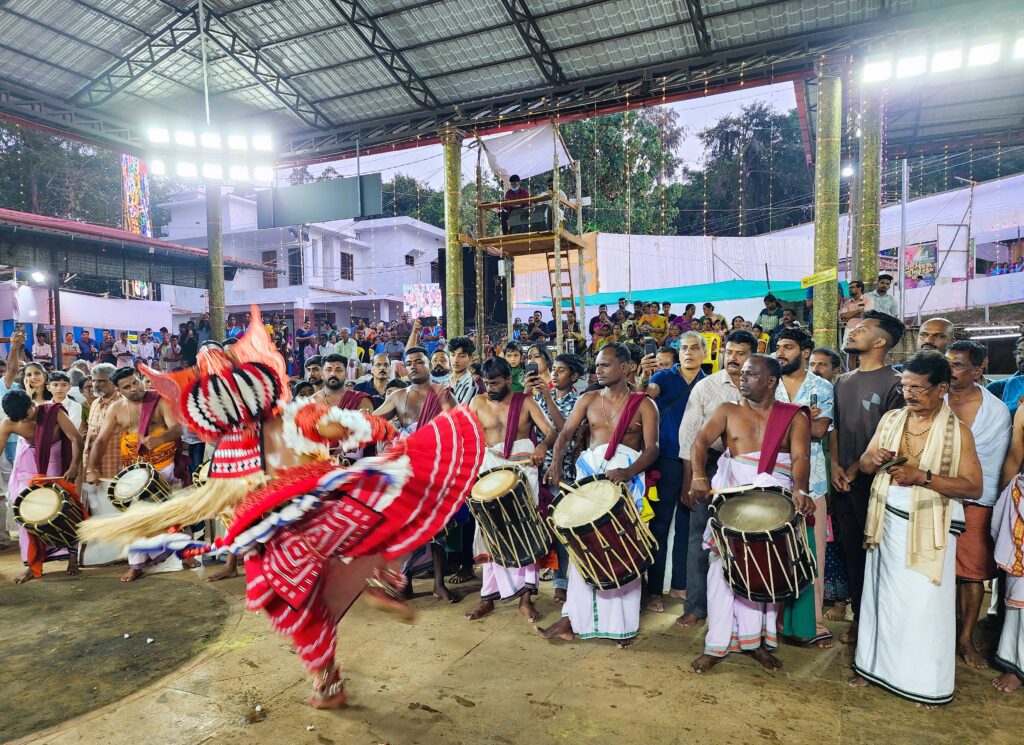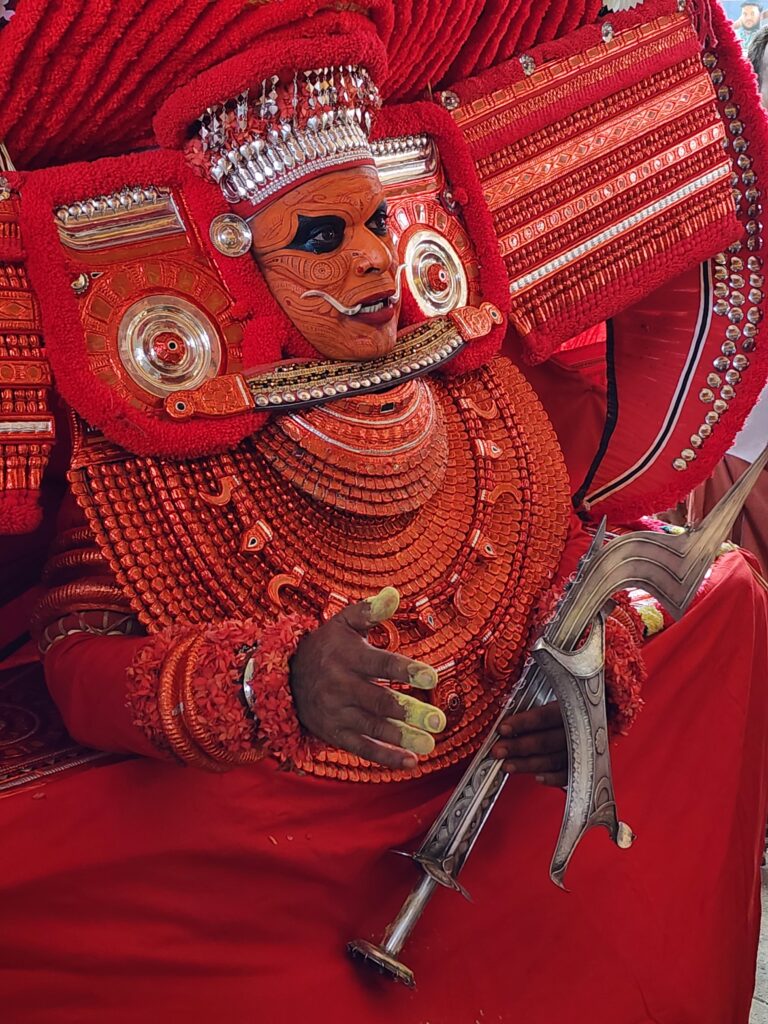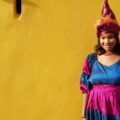Once a kolam
Extraordinary experiences make one a raconteur. Gopi sat in our midst, narrating tales animatedly but unhurriedly from his outings as a kolam, theyyam performer. Elaborate, gilt-laden headgear, sharp gleaming nails, metallic bulbous eyes, jangling anklets, all came out one by one from an ancient box unopened for many years. Most of it was a legacy handed down from his father. His own son, a schoolteacher, evidently proud of what his dad was, showed us time-stained photographs of a focused looking youngster with heavily kohled eyes, sporting a springy crown fashioned from palm leaves, striking an intense pose.
“That’s me, at the peak of my days as a kolam,” he beamed. Gopi tied the ornaments on some of my friends who wanted to try them on. His wife, a coy lady, who kept repairing into the kitchen after serving us rounds of coffee and snacks, brought in more damascene works including dewdrop-shaped earrings and chunky bracelets from somewhere inside. It was like parents showing off the many awards won by their prodigy child. Pride was in the air, and so infectious one couldn’t help but partake.
Arguably the highlight of any kolam career must be the Thee Chamundi when the performer, attired in a mask and skirt of coconut leaves flings himself into a mount of red-hot embers kept smoldering, sometimes bursting into flames through fanning. Gopi breaks into character every now and then.
“This is Prahlad, who was thrown into the fire by the asuras,” his eyes are wide and nostrils aflare, a low shrill cry permeates the room. “It’s his ardent devotion to Lord Vishnu which rescues him, eventually. But not before he plunges into fire several times over.”
Next, we are taken on a cicatrix tour like a proud war veteran flaunting proof of brave service with survival stories. Not vastly dissimilar if you look at it from a socio-religious angle – theyyam is a community reasserting itself, ensuring their relevance and continuance.
Daivam/theyyam
The term ‘theyyam’ is believed to be a derivation from the Sanskrit word ‘daivam’ meaning God. The performance itself is a dramatic possession on full display – of any one of the Hindu pantheons, a deified ancestor or folk hero. They could be animals or force of nature, or more contemporary ones like the Potten theyyam which tells the story of the Hindu sage and scholar, Adi Shankara. I was in the north of Kerala, collectively called the ‘Kolathunadu’ region – the home of theyyam – to watch specifically the story of Muchilottu Bhagavathy, among the most woke figures from mythology.
A beautiful, young girl, born in the Perinchellur area, now Thaliparambu, she had all the Vedas by heart at the age of 12. The all-male club of Brahmin scholars felt intimidated by her early wisdom that they decided to trap her in debate.
“What is the most pleasurable experience for man? And the most painful?”
Of course, the girl knew what was coming but couldn’t be untrue even if it was to save her own skin.
“The most pleasurable is sex and painful is childbirth.”
All hell broke loose: How can a virgin (is she?) know about sex or childbirth? Nudges and winks, ostracizing, wandering homeless, self immolation, all follow, in the earthly version of the tale. But in the empyrean ones she is Muchilottamma who was born from the sweat drops of Lord Shiva when he was doing the tandava. Note the thin fine line between man and God in these narratives.
There are around 600 kinds of theyyam rituals that come alive primarily between November and May, performed mostly by members of Dalit communities. Thus, established caste systems are turned on their heads – the untouchables are revered, and blessings sought with fervor. Manakkadan Raman Gurukkal, a tantric saint, who performed 39 kolam in a single night, for the Chirakkal King in Kannur is believed to be the forerunner and founder of the ritual. While there are several theories associated with its origins, theyyam is firmly associated with tantric rites for its offerings of meat and blood.
When these are transacted in the firelight from a burning pyre to the accompaniment of lugubrious pipes and jarring drums, by a hagio-fearsome kolam, in the wee hours prior to dawn, you are transported too.
There will be blood
We parked our vehicles by the road fringing an aphyllous field and walked towards a lone light in the distance. As we neared the temple, we could hear the drumming that rose to a crescendo swallowing the birdsong and the lone bark of a frightened mutt. Somebody took my hand, and I gave a gentle squeeze; an assuetude that grew from a happenstance meeting onboard a stranded flight in a different continent. The fire burned bright, lit up our faces and those of the gallery seated in awe and worship of a theyyam in full swing.
There is more to a kolam than legacy, caste, or a sense of rhythm. The invoking is real, which follows days, sometimes even weeks, of abstinence and prayers. As is the transformation after thorram, prayers and ablutions, vellattam, the body and face painting, and the ritual itself when the kolam appears wearing the mudi, the elaborate crown. His face wore a permanent, painful rictus, probably the burden of an increasingly harsher battle between good and evil, right and wrong, what we want and what we seek. The volutations were the physical manifestations of this raging conflict since the onset of man – and gods. High leaps and half cartwheels, loud screams and clanging sword, a cataphract on rampage. The atmosphere was equally electric as it was prayerful, a fiery stream of supplications for the Gods to continue being significant. And the Gods did play along: ‘If prayers weren’t granted, then the tradition wouldn’t have lasted through the ages,’ as a retired kolam pointed out.
Two roosters were brought out toward the end of the ritual which the kolam – who was now in a trance, movements feverish and staccato yelping, – proceeded to maul and mangle with bare hands and the sword. The spilling of blood on the arena points to a couple more theories of the origins of theyyam – hero worship and fertility rituals in agrarian societies. Gopi, who took us there, proceeded to enthrall us with the tale of a wronged battle hero who extracts his revenge. The drums slowed down to ruffs and the cymbals clanged gently as we left the venue. Sun opened shop over the arrish plains glistening with mist; we walked quietly left to our own thoughts – and takes.
To be or knot
Performing artistes who lived their prime on stage cannot stay far from it after retirement. I sat with an ex kolam along the sidelines of another theyyam in Kannur suburbs. He now arranged theyyam and organized the umpteen requirements for a successful staging. Come season and he was in demand: there was kaliyattam, theyyam organized by a joint family or a community in a specific area; perumkaliyattam, held every 10, 12, or 15 years; and the nerchakaliyattam, to celebrate rare events or occasions.
What got us talking was the extraordinarily large gold bangle with exquisite engravings he wore – a ceremonial appreciation by the heirs of the Chirakkal King’s dynasty for services to theyyam. He sat giving instructions to his costume team who were tying together the mirror-studded divinity crown with coconut husks, peacock feathers, shells, and nuts. A work so exemplary in its craftmanship that you won’t spot a single joint or knot on the facade. The vadyam, musical, team slept nearby on mats laid on the ground, huddled into each other, a quick snooze. Once season, the fervent energy keeps them going.
“Sleep deprivation is just a minor one,” he told me, touching on a topic I didn’t come across in any of the research I undertook on theyyam before I set out. A grave issue, I understood he was opening a can of worms previously undiscussed or written about.
“The costumes are fastened to the kolam’s body for hours through multiple chords knotted tightly,” he said. “Other knots are also tied which do away with the need for restroom breaks for hours it takes from preparation – makeup, dressing – to performance.” This leads to grievous health problems in the long run.
Upon my return and prior to writing this, I embarked on another research – and this time of a medical order – and found out about a condition called ‘compartment syndrome.’ Tight knots are one cause – building pressure, impairing circulation to the area and causative of potential tissue damage. If the pressure is too high, it can lead to tissue death, a permanent damage. There was no palavering, just plain stating of what they put themselves through. His own eyes were constantly on the fitters’ stitches going in and out of the crimson and fulvous gear getting ready for the next act. In our background the kolam winding up was walking around the shrine in less frenzied steps, chanting prayers, reciting prophecies, and granting blessings.
Some of the last, I hoped, he kept for himself.

















Excellent .Your letters are so powerful that you made the reader feel and watch the art.